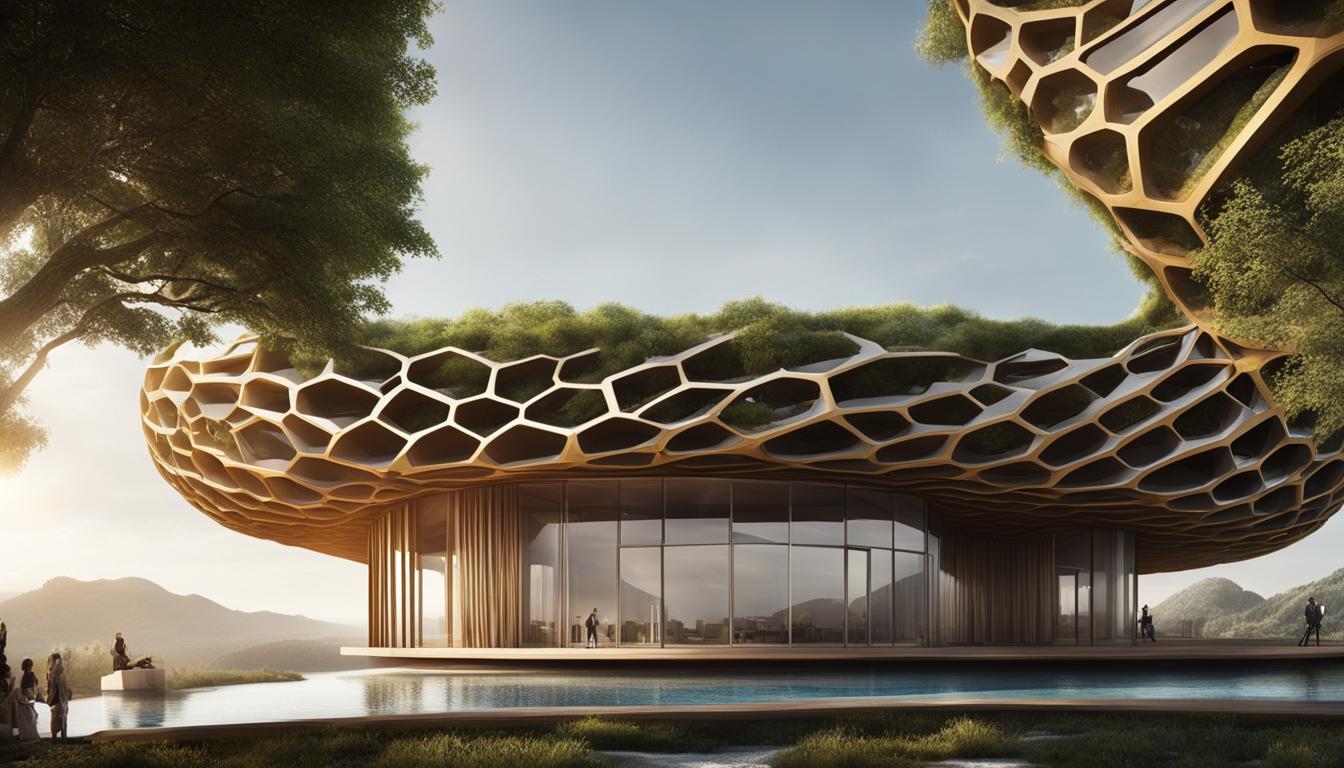Biomimicry in architecture is a unique and technical approach that draws inspiration from nature’s ingenuity to create sustainable and energy-efficient designs. By studying nature’s strategies and systems, architects can incorporate natural elements and emulate natural forms in their construction, resulting in environmentally friendly and aesthetically pleasing buildings.
Key Takeaways:
- Biomimicry in architecture involves mimicking nature’s strategies to create sustainable designs.
- Architects can learn from nature’s systems and incorporate natural elements in their construction.
- Biomimicry architecture can be categorized into organism, behavior, and ecosystem levels.
- Examples of biomimicry architecture include the Esplanade Theatre and the National Aquatics Center.
- Biomimicry in architecture offers benefits such as energy efficiency and the use of green building materials.
What is Biomimicry Architecture?
Biomimicry architecture is a method of sustainable design that involves imitating nature’s strategies and principles in creating architectural structures. It goes beyond simply taking inspiration from nature’s forms and aesthetics and focuses on replicating the functionality and efficiency found in natural systems. By studying and understanding nature’s processes, architects can design buildings that are not only visually pleasing but also function in a sustainable and efficient manner.
Biomimicry architecture can be categorized into three levels:
- Organism level: This level involves designing the form and facade of the structure to directly mimic nature. Architects draw inspiration from natural shapes, patterns, and textures, creating buildings that blend seamlessly with their surroundings.
- Behavior level: At this level, the design of the structure is inspired by the working or functioning of nature and its elements. Architects incorporate natural ventilation systems, efficient lighting strategies, and other elements that mimic nature’s processes to enhance energy efficiency and occupant comfort.
- Ecosystem level: The ecosystem level of biomimicry architecture revolves around creating self-sufficient and sustainable structures inspired by the resilience and regenerative abilities of natural ecosystems. Architects strive to design buildings that harmonize with their environment, utilize renewable resources, and minimize waste.
By embracing biomimicry in architecture, designers can not only create visually stunning buildings but also contribute to a more sustainable future by harnessing the efficiency and ingenuity of nature.
Categories of Biomimicry Architecture
Biomimicry architecture can be categorized into three levels: organism level, behavior level, and ecosystem level. Each level offers unique ways for architects to implement biomimicry principles in their designs, resulting in more sustainable and environmentally-friendly built environments.
Organism Level:
At the organism level, the focus is on mimicking the form and facade of natural structures. Architects draw inspiration from nature’s shapes, patterns, and textures to create buildings that visually resemble elements found in the natural world. By emulating nature’s aesthetics, architects can integrate the beauty and harmony of the natural environment into their designs, promoting a sense of balance and connection with nature.
Behavior Level:
At the behavior level, biomimicry architecture goes beyond aesthetics and delves into replicating the functioning and operational principles of natural systems. Architects study how nature solves various challenges and adapt those solutions to design buildings that function in a more sustainable and efficient manner. This level of biomimicry architecture may involve incorporating natural ventilation systems, optimizing natural light to reduce energy consumption, or creating self-regulating structures that respond to environmental changes.
Ecosystem Level:
The ecosystem level of biomimicry architecture takes inspiration from nature’s regenerative and efficient systems. Architects aim to create self-sufficient and sustainable structures that mimic the resilience and adaptability seen in ecosystems. This level may involve integrating technologies such as renewable energy systems, rainwater harvesting, or green roofs, which mimic the functions of ecosystems in supporting life and reducing environmental impact.
By categorizing biomimicry architecture into these levels, architects have a framework to guide their design process and incorporate sustainable practices at different levels. This approach enables the creation of innovative and environmentally-friendly buildings that are not only visually appealing but also harmonious with the natural world.

Examples of Biomimicry Architecture
There are several examples of biomimicry architecture that showcase the integration of nature-inspired design principles and sustainable construction practices.
“Biomimicry architecture takes inspiration from nature to create innovative and sustainable structures.”
One such example is the Esplanade Theatre in Singapore, which mimics the hard thorn exterior of the Durian fruit to create a responsive shading system.
Another example is the National Aquatics Center in Beijing, which takes inspiration from water bubbles to create an efficient and translucent bubble cladding.
The Gherkin in London is designed to mimic the shape and lattice structure of the Venus Flower Basket Sponge.
The Beijing National Stadium resembles old Chinese art and a bird’s nest in its design.
The Eastgate Centre in Zimbabwe utilizes the natural cooling system of termite mounds to create a sustainable and energy-efficient building.
The Eden Project in England takes inspiration from soap bubbles to design its sustainable greenhouse.
Examples of Biomimicry Architecture
| Building | Biomimicry Inspiration |
|---|---|
| Esplanade Theatre in Singapore | Hard thorn exterior of the Durian fruit |
| National Aquatics Center in Beijing | Water bubbles |
| Gherkin in London | Venus Flower Basket Sponge |
| Beijing National Stadium | Old Chinese art and a bird’s nest |
| Eastgate Centre in Zimbabwe | Termite mounds |
| Eden Project in England | Soap bubbles |
These examples demonstrate the versatility and potential of biomimicry in architecture to create innovative and sustainable structures.
Benefits of Biomimicry in Architecture
Biomimicry in architecture offers numerous benefits for sustainable design, energy efficiency, and green building practices.
One of the key advantages of biomimicry is its ability to create buildings that are more energy-efficient. By imitating nature’s strategies and principles, architects can design structures that optimize natural light and ventilation systems. This reduces dependence on artificial lighting and air conditioning, resulting in lower energy consumption and reduced carbon footprint.
Biomimicry also promotes the use of green building materials derived from renewable resources. By integrating natural and sustainable materials into construction, such as bamboo, reclaimed wood, or recycled materials, architects can reduce the environmental impact of the built environment. This not only conserves natural resources but also minimizes waste generation and supports a circular economy.
Furthermore, incorporating biomimicry principles in architecture can contribute to the attainment of green building certifications, such as LEED (Leadership in Energy and Environmental Design). These certifications recognize and reward buildings that meet specific sustainability criteria, including energy efficiency, water conservation, and indoor environmental quality. By implementing biomimicry-inspired designs and sustainable practices, architects can increase the chances of obtaining green building certification, enhancing the overall value and marketability of the building.
Overall, biomimicry in architecture fosters the development of more sustainable and environmentally friendly built environments. Through the utilization of nature-inspired design principles, energy-efficient systems, and green building materials, architects can create buildings that harmonize with nature, reduce their ecological footprint, and contribute to a more sustainable future.

Challenges in Implementing Biomimicry in Architecture
While biomimicry offers immense potential for sustainable design in architecture, there are several challenges that arise in its implementation. These challenges often revolve around the integration of nature-inspired concepts and materials into traditional construction practices, which may require significant changes and adaptations. Let’s take a closer look at the specific challenges faced in implementing biomimicry in architecture:
1. Availability and Accessibility of Green Building Materials
One of the challenges is the limited availability and accessibility of green building materials inspired by nature. Developing and producing such materials can be costly, and their quantity may not meet the demand. This poses a hurdle for architects and designers who want to incorporate sustainable and eco-friendly materials into their projects.
2. Integration of Biomimicry Principles into Construction Practices
Integrating biomimicry principles into existing construction practices can be a complex task. Architects and builders need to make significant changes and adaptations to incorporate nature-inspired design elements effectively. This includes reimagining traditional construction methods to align with the principles of sustainable design, energy efficiency, and green building materials.
3. Technical and Logistical Challenges
Mimicking nature’s complex systems and processes in architecture can pose technical and logistical challenges. Architects must navigate the intricacies of recreating natural functionalities within built structures, considering factors such as structural integrity, maintenance, and durability. Additionally, the integration of energy-efficient systems and technologies inspired by nature may require careful planning and implementation.
Despite these challenges, architects and designers are embracing biomimicry due to its numerous benefits in sustainable design and energy efficiency. By overcoming these obstacles, the industry can continue to evolve and create environmentally-friendly built environments.
The Future of Biomimicry in Architecture
The future of biomimicry in architecture holds significant potential for sustainable development and eco-friendly design. As the demand for sustainable buildings and practices continues to grow, architects and designers are increasingly looking to nature for inspiration and solutions.
Advancements in technology and material science have the potential to further enhance the integration of biomimicry principles in building design and construction. Architects can leverage these advancements to create structures that not only mimic nature’s forms but also replicate its efficiency and functionality. By studying and understanding nature’s sustainable systems, architects can discover innovative ways to design and construct buildings that are more energy-efficient, resource-conserving, and environmentally friendly.
Incorporating renewable energy systems inspired by natural processes is another area of focus for the future of biomimicry in architecture. By drawing inspiration from nature’s energy systems, such as solar panels and wind turbines, architects can create buildings that generate their own renewable energy, reducing reliance on traditional power sources and minimizing their impact on the environment.
Ongoing research and innovation in the field of biomimicry will continue to shape the future of architecture. By pushing the boundaries of design and technology, architects can explore new possibilities and create structures that harmoniously coexist with nature. As society becomes more conscious of the need for sustainable development and eco-friendly design, biomimicry will play a vital role in creating a greener and more sustainable future.
Conclusion
Biomimicry in architecture offers architects and designers a powerful approach to creating sustainable and energy-efficient buildings that are inspired by nature’s ingenuity. By studying and imitating nature’s strategies and systems, architects can design structures that not only function like nature but also contribute to the preservation and conservation of the environment. Incorporating biomimicry principles into architectural design allows for the use of natural materials, efficient ventilation systems, and other nature-inspired elements, creating greener and more sustainable built environments.
As the demand for sustainable design practices continues to increase, biomimicry in architecture holds great promise for the future. Architects and designers are increasingly looking to nature for inspiration and solutions, recognizing the potential to shape a more sustainable and eco-friendly future for the industry and the planet. Advancements in technology and material science further enhance the integration of biomimicry principles in building design and construction, paving the way for innovative and environmentally conscious architectural solutions.
By embracing biomimicry in architecture, the industry can address pressing environmental challenges and contribute to a greener future. Through the use of green building materials, energy-efficient systems, and nature-inspired design, architects and designers can create buildings that not only meet the needs of the present but also contribute to the long-term sustainability of our built environment. By harnessing nature’s wisdom and applying it to architectural design, biomimicry offers a pathway towards a more harmonious and sustainable relationship between human-made structures and the natural world.
FAQ
What is biomimicry architecture?
Biomimicry architecture is a method of sustainable design that involves imitating nature’s strategies and principles in creating architectural structures. It goes beyond simply taking inspiration from nature’s forms and aesthetics and focuses on replicating the functionality and efficiency found in natural systems.
What are the categories of biomimicry architecture?
Biomimicry architecture can be categorized into three levels: organism level, behavior level, and ecosystem level. At the organism level, the form and facade of the structure are directly inspired by nature. At the behavior level, the design of the structure is inspired by the functioning of nature. At the ecosystem level, the structure is inspired by creating a self-sufficient and sustainable environment.
Can you provide some examples of biomimicry architecture?
Yes, there are several examples of biomimicry architecture that showcase the integration of nature-inspired design principles and sustainable construction practices. Examples include the Esplanade Theatre in Singapore, the National Aquatics Center in Beijing, the Gherkin in London, the Beijing National Stadium, the Eastgate Centre in Zimbabwe, and the Eden Project in England.
What are the benefits of biomimicry in architecture?
Biomimicry in architecture offers benefits in terms of sustainable design, energy efficiency, and green building practices. It allows for the creation of more energy-efficient buildings, promotes the use of green building materials, and contributes to the attainment of green building certifications.
What are the challenges in implementing biomimicry in architecture?
Some challenges in implementing biomimicry in architecture include the availability and accessibility of green building materials, the integration of biomimicry principles into existing construction practices, and the technical and logistical complexities of mimicking nature’s systems and processes.
What does the future hold for biomimicry in architecture?
The future of biomimicry in architecture holds significant potential for sustainable development and eco-friendly design. As the demand for sustainable buildings and practices continues to grow, architects and designers are increasingly looking to nature for inspiration and solutions. Advancements in technology and material science are expected to further enhance the integration of biomimicry principles in building design and construction.
Source Links
- https://www.archdaily.com/954004/what-is-biomimetic-architecture
- https://www.re-thinkingthefuture.com/rtf-fresh-perspectives/a952-10-stunning-examples-of-biomimicry-in-architecture/
- https://parametric-architecture.com/nature-inspired-design-biomimicry-in-architecture/
- Regulatory and Compliance: Pioneering the Future of Saudi Arabia’s Dedicated Cargo Airline - December 21, 2024
- Financial Strategies: Fueling the Growth of Saudi Arabia’s Dedicated Cargo Airline - December 20, 2024
- Operational Excellence: Ensuring Competitive Edge for Saudi Arabia’s Dedicated Cargo Airline - December 19, 2024






